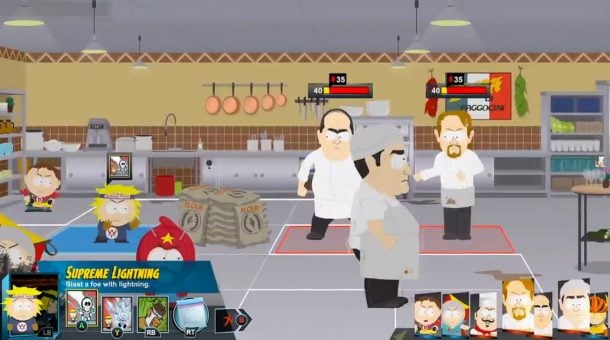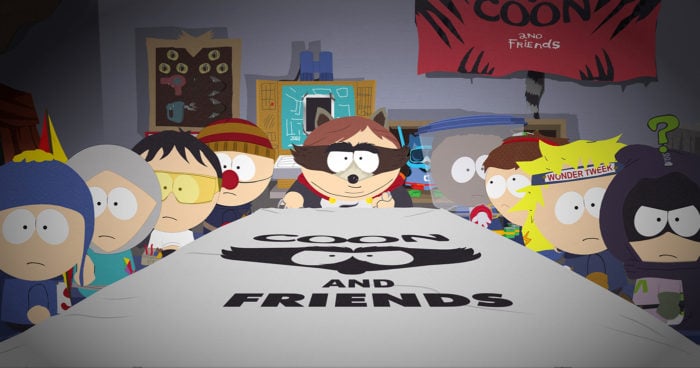In a year full of great role-playing games like NieR: Automata, Nioh, and Persona 5, no other title is just as deserving to be on any RPG fan’s list of games to play in 2017 than South Park: The Fractured But Whole. A franchise that was already engaging last generation in The Stick of Truth is even more captivating this time around, not only giving players the feeling as though they’re playing an actual episode of the series but providing a rich array of typical RPG elements to incentivize playing the title more and more.
This can best be attributed to a robust customization process, complex tactical combat, and a fleshed out crafting system, not to mention a deep love for the game’s source material exemplified in The Fractured But Whole’s locations. Most of these areas are fully explorable, meaning fans of the show will be able to scour places like South Park Elementary School, Historic Sodosopa, Tweek Bros Coffee, and Cartman’s basement (or in this game’s case, the Coon’s Lair) to their heart’s content, all while encountering fan favorite characters and collecting all kinds of loot like Yaoi Art. This works largely to the same effect as long-running RPG franchises like Final Fantasy, as recurring items and Easter eggs are fun nods to previous entries in the series.
Rest assured that those RPG fans out there that aren’t so well-studied on South Park lore won’t at all be lost with this game, however, as South Park’s signature all-too-real humor establishes itself right from the get-go. During The Fractured But Whole’s character creation process, for instance, players will be able to tweak all manner of physical attributes for their avatar like hairstyle, hair color, and facial features. There’s also a “difficulty” category, which allows fans to switch from “very easy” to “very difficult” and thereby change their character’s skin color from ghostly white to black.
Don’t be fooled by the crude humor, as The Fractured But Whole provides a surprisingly deep means of customization that’s more than just cosmetic – something very much in the same league of titles like Dragon Age: Inquisition and Mass Effect 2. Whereas The Stick of Truth allowed for only male avatars, players can now create female and non-binary avatars too. Fans can customize their character according to their ideal gameplay style, as not only can all manner of clothing items like helmets, gloves, and superheroic outfits be unlocked, purchased, or created, but multiple character classes can be chosen. A selection of twelve character classes are available, each with an array of different abilities able to be deployed in the game’s tactical turn-based combat system.

Speaking of gameplay, players will be able to maneuver characters around a hex-based map to position them in the ideal place for battle. This is a step up from Stick of Truth’s stationary means of combat and requires a great deal of strategy and thought (though this will feel a bit simplistic for veterans of the tactical RPG genre). There are multiple unlockable characters to assist players in battle too, adding greater variety and a bit more difficulty in finding the perfect takedown. Combat encounters require that players learn the ins and outs of the game, thus utilizing each party member’s abilities to create the best combinations and exploit enemy weaknesses. This works much in the same vein as Final Fantasy Tactics titles, as players are able to swap out party members based on stats and what gameplay most suits their personal preference, thus allowing them a great degree of freedom.
Indeed, the added dimension of movement and positioning on a 3D grid makes fights feel much more dynamic, especially when taking into consideration obstacles, abilities to protect lines of sight, super moves, and timed bomb attacks that deal massive damage to defined grid blocks. Players will be constantly planning movement to best capitalize on party abilities and avoid incoming attacks, so it shouldn’t come as much of a surprise should they find themselves thinking over strategies between turns at length. It’s a deep and rewarding experience when players finally see their strategy come to successful fruition, which is a feeling that no RPG fan is unfamiliar with.
Aside from the depth that combat now provides, the newest South Park game fleshes out skill trees, allowing players to collect artifacts around the town and apply various stat-boosting abilities accordingly. These artifacts work hand-in-hand with the game’s new crafting mechanic, hysterically introduced by Morgan Freeman and his taco business. The character explains in his well-known voice how foods found when looting people’s houses and trash cans can be combined to form new healing items to be used in battle or buff a character’s powers in different ways – something that will be essential when taking on stronger enemies.

Rest assured that as players craft items they will acquire crafting points, which will allow them to create more useful items in greater quantities. Though it may sound complicated, the mechanic is simple to use in practice. Crafting plays into the game’s environmental puzzles, which allows players to manipulate scenes or break-down/move items to reach new areas and earn new gear or quest-related goodies, continuously engaging players by tying together aspects of the game as in any good RPG. In fact, The Witcher 3: Wild Hunt – arguably the best RPG this console generation among critics and fans alike – uses its alchemy system in largely the same way.
South Park: The Fractured But Whole is worth any RPG fan’s time beyond its refined combat and added depth. It seamlessly melds together fundamental elements of a great role-playing experience with the crudeness that makes the franchise so great, thus providing a much-needed deviation from the standard seriousness the genre is known for. It wouldn’t be much of a stretch to say The Fractured But Whole rejuvenates RPGs in general, really, and establishes itself as a must-play title in the same league of any NieR, Nioh, or Persona before it.
